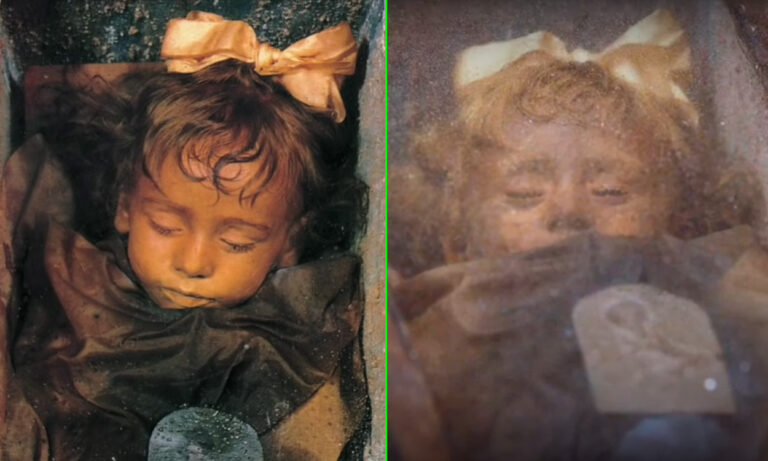Preserved body of a two-year-old girl is said to be the ‘world’s most beautiful mummy’
In the depths of the Capuchin catacombs of Palermo, Sicily, lies the body of a two-year-old girl called Rosalia Lombardo—who tragically passed away due to pneumonia caused by the Spanish Flu on 6 December 1920. At the time, her father approached an embalmer and taxidermist named Alfredo Salafia so that he could preserve his child in a glass-topped coffin.
Today, over a century later, Lombardo’s mummified body lies intact with all her internal organs. Her skin still appears smooth as her hair remains tied back with a large silk bow on the top of her head. And, perhaps more hauntingly, Lombardo’s crystal blue irises are visible under her blonde eyelashes—making her seem like a child who is merely napping and could awake at any moment.
Resting on a wooden pedestal among 8,000 other mummies, thousands of people come to visit the two-year-old’s preserved body in the catacombs underneath the Capuchin convent. Her frame is covered with a blanket, leaving only her face visible to the crowd. Lombardo is now nicknamed the “sleeping beauty of Palermo” and is often described as being “the most beautiful mummy in the world.”

Over the years, a number of bizarre theories have emerged about Lombardo’s remains, with some even claiming that her body is a fake wax replica. Several tests have since been reportedly performed for a History Channel documentary in the 2000s looking to debunk these statements. Not only did the MRI scans, X-rays and 3D images confirm the mummy to be the body of Lombardo, researchers even discovered that her skeletal structure and internal organs were still intact—including her brain, which had shrunk to 50 per cent of its original size.
However, there was one urban legend that continued to haunt visitors: many people have reported witnessing the young girl slowly open and close her eyes, in turn, earning her the title of “blinking mummy.” Several time-lapse videos featuring images of Lombardo’s body taken hours apart also went on to grip the broader internet—where she appeared to have opened her eyes by a fraction of an inch.
While some believed supernatural forces were at work, enabling the two-year-old’s mummified body to blink, others claimed this was due to the temperature changes inside the catacomb which compelled her eyelids to contract and produce the blink-like effect.
But it wasn’t until 2009, when Italian paleopathologist Dario Piombino-Mascali came aboard and debunked the mystery that the internet rested Lombardo’s unusual case. “It’s an optical illusion produced by the light that filters through the side windows, which during the day is subject to change,” the expert said in a statement, as noted by ScienceAlert.
Piombino-Mascali made this discovery when he noticed that workers at the museum had moved the mummy’s case, which caused her to shift slightly and allowed him to see her eyelids better than ever before. “They are not completely closed, and indeed they have never been,” he went on to state. In short, when the light changes and hits her eyes at different angles, it can appear as though the eyes are opening and closing.
By tracking down the embalmer’s living relatives, the paleopathologist also managed to uncover the elusive formula that was used for Lombardo’s noteworthy preservation. After going through several documents obtained from Alfredo Salafia’s family, Piombino-Mascali stumbled upon a handwritten memoir in which the embalmer had recorded the chemicals he injected into the two-year-old’s body.
Now, typical embalming procedures include the complete removal of organs. The empty body is then filled with natron salts, which help desiccate the remains. But Salafia did something different. In his memoir, he detailed that he had made a small puncture wound and injected a mixture of formalin, zinc salts, alcohol, salicylic acid, and glycerin into Lombardo’s body following her death.
While formalin—which is now used by embalmers worldwide—helped eliminate bacteria, salicylic acid removed any fungi present in the flesh and glycerin prevented the young girl’s body from drying out. But according to Melissa Johnson Williams, executive director of the American Society of Embalmers, zinc salts was the magical element that is responsible for Lombardo’s preservation.
“Zinc gave her rigidity,” Williams told National Geographic. “You could take her out of the casket, prop her up, and she would stand by herself.”
Today, Lombardo is housed in a new glass case filled with nitrogen, specifically curated to protect her remains from oxygen, light, and even tourists. “It was designed to block any bacteria or fungi. Thanks to a special film, it also protects the body from the effects of light,” Piombino-Mascali continued in his statement, adding that he hopes tourists will stop fabricating “totally unfounded stories” about the world’s most beautiful mummy.





